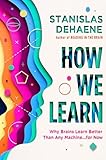How we learn : why brains learn better than any machine ... for now / Stanislas Dehaene.
Material type: TextLanguage: English Original language: French Publication details: New York, New York : Viking, (c)2020.Edition: First American editionDescription: xxviii, 319 pages, 16 unnumbered pages of plates : illustrations ; 24 cmContent type:
TextLanguage: English Original language: French Publication details: New York, New York : Viking, (c)2020.Edition: First American editionDescription: xxviii, 319 pages, 16 unnumbered pages of plates : illustrations ; 24 cmContent type: - text
- unmediated
- volume
- 9780525559887
- 9780525559894
- BF318 .H699 2020
- BF318
- COPYRIGHT NOT covered - Click this link to request copyright permission:
| Item type | Current library | Collection | Call number | Status | Date due | Barcode | |
|---|---|---|---|---|---|---|---|
 Circulating Book (checkout times vary with patron status)
Circulating Book (checkout times vary with patron status)
|
G. Allen Fleece Library CIRCULATING COLLECTION | Non-fiction | BF318.D322.H699 2020 (Browse shelf(Opens below)) | Available | 31923001904784 |
Based in part on: Apprendre! : les talents du cerveau, le defi des machines.
Seven definitions of learning -- Why our brain learns better than current machines -- Babies' invisible knowledge -- The birth of a brain -- Nurture's share -- Recycle your brain -- Attention -- Active engagement -- Error feedback -- Consolidation -- Conclusion. Reconciling education with neuroscience.
"In today's technological society, with an unprecedented amount of information at our fingertips, learning plays a more central role than ever. In How We Learn, Stanislas Dehaene decodes its biological mechanisms, delving into the neuronal, synaptic, and molecular processes taking place in the brain. He explains why youth is such a sensitive period, during which brain plasticity is maximal, but also assures us that our abilities continue into adulthood, and that we can enhance our learning and memory at any age. We can all 'learn to learn' by taking maximal advantage of the four pillars of the brain's learning algorithm: attention, active engagement, error feedback, and consolidation. The human brain is an extraordinary machine. Its ability to process information and adapt to circumstances by reprogramming itself is unparalleled, and it remains the best source of inspiration for recent developments in artificial intelligence. The exciting advancements in A.I. of the last twenty years reveal just as much about our remarkable abilities as they do about the potential of machines. How We Learn finds the boundary of computer science, neurobiology, and cognitive psychology to explain how learning really works and how to make the best use of the brain's learning algorithms, in our schools and universities as well as in everyday life"--
COPYRIGHT NOT covered - Click this link to request copyright permission:
There are no comments on this title.
